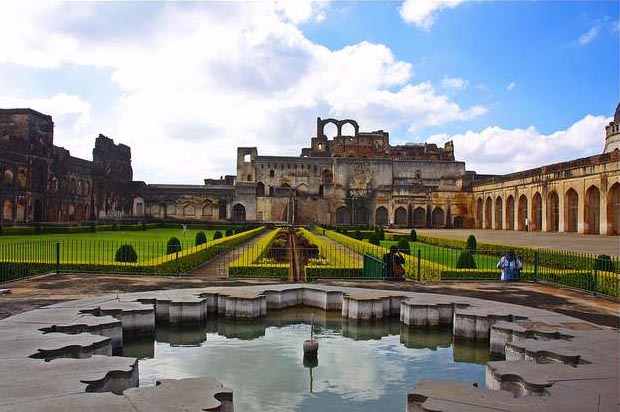Rangin Mahal

Information on Rangin Mahal (Bidar, Karnataka) - History & Architecture
Rangin Mahal which is one of the integral parts of the Bidar Fort, is located in the state of Karnataka. It was built in the year 1524 by the Bidar rulers. The Mahal is also titled as the colored Mahal as it is decorated with tiles of diverse colors which can be depicted from the existed traces within the area of the fort.
Rangin Mahal Architecture
The Mahal depicts the artistic taste of the King of Bahmani and King Ali Barid. The architecture of the Mahal has a fusion of both the Hindu and Muslim art especially in the paintings and the decorations on the wall. Notably, traces remains within the Mahal suggested that aspects such as stone carving, stucco as well as floral work within interior of the Mahal are among magnificent feature of the monument. The interior of the hall has walls and ceilings which has the decoration of 'Mother of Pearl' along with mosaics. The wooden columns within the interior of the Mahal is also an important part of the architecture. The floor has the work of mosaic and colorful tile work which catches the attention of the eye. There are also verses of Quran written on the walls of the monument that portrays the religious aestheticism of its architecture. After it was redesigned by king Barid, some of the rooms were decorated with wood carvings and were ornamented with pearls. This also enhanced the beauty of the overall Mahal.
Rangin Mahal History
Built in the year 1524, the monument was originally constructed by King Mahmud Shah Bahmani. Historical facts suggests that some part of the fort especially its part was built by Ali Barid Shah who was a Bidar ruler. The monument is believed to be one of the best preserved in the history of the state. The monument is also popular as the title of queen palace as women from various nationalities resided in it. This huge Mahal is closed by a famous darwaza which is also known as Gumbad darwaza. It has been recorded that in order to gain power over the rivals in the year 1487, King Bahmani shifted from the royal palace to the ranging Mahal. The king took shelter in the Shah Burz section of the Mahal. During his stay, the king experienced the feeling that the Mahal is favorable to stay and thus the king permanently shifted from the royal palace to the Rangin Mahal. Furthermore, in the early 16th century King Ali Barid took the initiative to improve the Mahal by improving its interior. The Mahal has a large hall where the visitors can be able to experience work of the ancient artisans during the period of 15-16 century.
Rangin Mahal Tourism Importance
In the present day scenario, the Mahal is being used by the administration for the tourists. In order to preserve it, the state government rebuilt some of the deteriorated parts. It has been managed by the ASI and tourists will need to take special permission to enter the interior of the fort. Easy access to the place from various places of Karnataka also makes it appropriate to be used for tourism purpose. Apart from that its historical and architectural importance add to its tourism value significantly. So being an important historical architecture figure, Rangain Mahal even today depicts the beauty of the era gone by and due to its presence, one can still soak in the glory that once the Mahal witnessed.
- Bangalore Monuments
- Bagalkot Monuments
- Belgaum Monuments
- Bellary Monuments
- Bidar Monuments
- Bijapur Monuments
- Chitradurga Monuments
- Coorg Monuments
- Dakshina Kannada Monuments
- Gadag Monuments
- Gulbarga Monuments
- Hassan Monuments
- Mysore Monuments
- Raichur Monuments
- Uttara Kannada Monuments
- Yadgir Monuments
- Andaman Nicobar Monuments
- Andhra Pradesh Monuments
- Assam Monuments
- Bihar Monuments
- Chhattisgarh Monuments
- New Delhi Monuments
- Goa Monuments
- Gujarat Monuments
- Haryana Monuments
- Himachal Pradesh Monuments
- Jammu and Kashmir Monuments
- Karnataka Monuments
- Kerala Monuments
- Madhya Pradesh Monuments
- Maharashtra Monuments
- Odisha Monuments
- Punjab Monuments
- Rajasthan Monuments
- Tamil Nadu Monuments
- Telangana Monuments
- Uttar Pradesh Monuments
- West Bengal Monuments